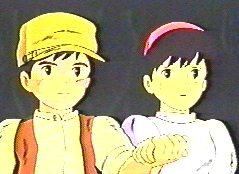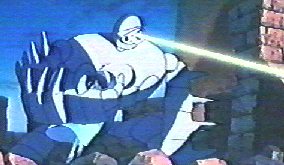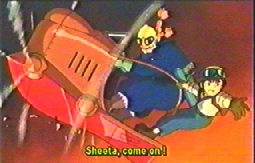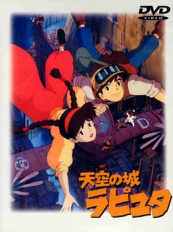
|
|
Pazu and Sheeta.
|
The people over at Disney have cast their eyes to the East in search of new inspiration for their full legnth animated films. We're not talking about next summer's Chinese-themed Mulan, but Disney's long term strategy. Because their last few movies drawn from history and literature didn't exactly set the box office on fire, Disney has been looking for other models to emulate. The only other dynasty of family-oriented animation anywhere else is in the world is in Japan: The collected works of Hayao Miyazaki.
Most of you reading this now know that animation in general is more popular in Japan than in the States. Popular animated shows can be seen in Japan during prime time, and there is a healthy market for original animation released straight to video for all ages and tastes. But even so, Miyazaki's films have a level of popularity that dwarfs them all. Every film that Miyazaki has directed since 1984's Nausicaa of the Valley of the Wind has been the top grossing film in Japan the year it was released. Miyazaki's latest, Princess Mononoke, has not only broken all previous box office records for Japan, it stomped them into dust, put the dust in boiling water, and drank them like tea.
Disney, needless to say, decided they wanted to get in on this action. Last summer, Disney bought the international rights to all of the films from Miyazaki's Studio Ghibli save one (whose rights are owned by someone else) and has announced that they will begin releasing them on tape stateside sometime in the indeterminate future. When that happens, our subject for today, Laputa, Castle in the Sky, should be among them.
Laputa, Castle in the Sky opens with a sad little girl (she seems to be the prisoner of some sinister-looking men) on an airship flying thousands of feet in the air. The ship is attacked by sky pirates, apparently looking for her. The little girl knocks out one of her captors, takes a pendant from one of his pocket, and climbs out the window. She does so just as the pirates break into the room, and in all of the confusion, she falls.

|
Kick-ass robots with hearts of gold–
didn't we tell you this was a great film?
|
Miraculously, she does not fall to her death. The pendant somehow causes her to float gently to the ground, where she is found by young Pazu, an orphan who works at the local coal mine as an assistant engineer. Pazu decides to help the little girl, Sheeta, escape from her troubles. Soon it becomes obvious that there are at least three groups after Sheeta and her pendant: The Dola sky pirates (led by the grenade-chucking Mama), the military, and the mysterious secret agents seen at the beginning of the film. For a while Sheeta and Pazu get chased around before being captured by the military.
It turns out that Sheeta is a princess of the lost flying city Laputa, and that her pendant is the key to finding the the city. Pazu, whose father was the only man known to have seen the lost city, dedicates himself to finding Laputa and returning Sheeta to her birthright.
Although the basic storyline (intrepid young hero rescues princess) is as cliche as can be, the world Miyazaki has created here is unlike any you've seen in any animated film, especially one made by Disney. Vaguely post-apocalyptic, this (mostly) pre-industrial society has produced a mix of simple farm life and fabulously complex propeller-driven flying machines. Laputa itself is wondrous.
We have little doubt that Laputa, Castle in the Sky will grab the attention of young American moviegoers. The movie has young heroes, appropriately sinister villains, and a cast of charming incidental characters. An added bonus is that these characters manage to have interesting and meaningful conversations without the aid of Broadway-composed expositional songs. We love the formula that The Little Mermaid set forth, but come on! Can't characters go five minutes without singing anymore?

|
Where does he get
those wonderful toys?
|
What will instantly pull most viewers into the story is the extremely likeable main characters. Sheeta is a cute and innocent, and you can't help but feel her plight. Pazu is a tough little scrapper, a little bulldog. Like most of the main characters in Miyazaki films, they are humanistic to the point of pacifism. The heroes in this film never take pleasure in hurting people, nor is the plot developed in such a way that the main characters can fight or shoot their way to the conclusion.
Another thing present in Laputa that sets it apart from American-made animated films is its sense of tenderness and sentimental humor. One scene involves Sheeta's new role as the cook on board a flying ship. Enamored of Sheeta (or at least the promise of decent food), the crew filters in one by one to help her prepare the first meal. It's a moment you wouldn't see in an animated film here in the States.
As with all Miyazaki films, the animation is fantastic. The quiet moments are poetic and beautiful, and the action scenes can easily compare to those in any current Disney movie. Granted, this movie was made more than a decade ago, and the animation has a 'drawn' look that current animated fare avoids. Don't let that bother you. Miyazaki's animation, even in the face of Disney's modern computer-assisted animation, is some of the smoothest and most realistic in the world.
Do we sound as if we're defending Laputa's differences from Disney films at every turn? Perhaps that's because non-Disney animation has yet to fully succeed here in the States. Even the other studios hoping to compete in the animated realm are following the Mickey Mouse formula – witness the recent release of Fox's Anastasia. We would really like to see some quality animation in theaters that didn't play out like a Broadway musical – it's ironic that it may come by way of Disney after all.









